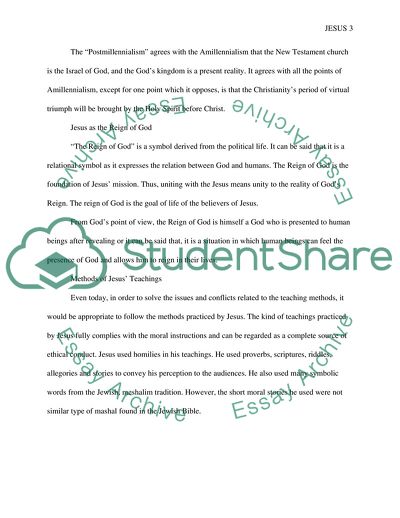Cite this document
(View of Teaching of Jesus from Different Perspectives Literature review Example | Topics and Well Written Essays - 2250 words, n.d.)
View of Teaching of Jesus from Different Perspectives Literature review Example | Topics and Well Written Essays - 2250 words. https://studentshare.org/religion-and-theology/1833806-the-reign-of-god-was-central-to-jesuss-ministry-and-self-identity-discuss-and-critically-evaluate-contemporary-discussion-regarding-jesus-presentation-of-gods-reign-and-his-attitudes-to-its-eschatological-or-otherwise-dimensions
View of Teaching of Jesus from Different Perspectives Literature review Example | Topics and Well Written Essays - 2250 words. https://studentshare.org/religion-and-theology/1833806-the-reign-of-god-was-central-to-jesuss-ministry-and-self-identity-discuss-and-critically-evaluate-contemporary-discussion-regarding-jesus-presentation-of-gods-reign-and-his-attitudes-to-its-eschatological-or-otherwise-dimensions
(View of Teaching of Jesus from Different Perspectives Literature Review Example | Topics and Well Written Essays - 2250 Words)
View of Teaching of Jesus from Different Perspectives Literature Review Example | Topics and Well Written Essays - 2250 Words. https://studentshare.org/religion-and-theology/1833806-the-reign-of-god-was-central-to-jesuss-ministry-and-self-identity-discuss-and-critically-evaluate-contemporary-discussion-regarding-jesus-presentation-of-gods-reign-and-his-attitudes-to-its-eschatological-or-otherwise-dimensions.
View of Teaching of Jesus from Different Perspectives Literature Review Example | Topics and Well Written Essays - 2250 Words. https://studentshare.org/religion-and-theology/1833806-the-reign-of-god-was-central-to-jesuss-ministry-and-self-identity-discuss-and-critically-evaluate-contemporary-discussion-regarding-jesus-presentation-of-gods-reign-and-his-attitudes-to-its-eschatological-or-otherwise-dimensions.
“View of Teaching of Jesus from Different Perspectives Literature Review Example | Topics and Well Written Essays - 2250 Words”. https://studentshare.org/religion-and-theology/1833806-the-reign-of-god-was-central-to-jesuss-ministry-and-self-identity-discuss-and-critically-evaluate-contemporary-discussion-regarding-jesus-presentation-of-gods-reign-and-his-attitudes-to-its-eschatological-or-otherwise-dimensions.


